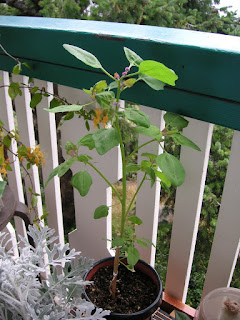


I've thoroughly enjoyed watching my tadpoles. Almost all of them were released from their egg sacs the day after I
first posted pictures on 05/30/11 making them 1 month old. Most of the time they simply rest on the bottom of the aquarium, not too exciting. Around mid-morning and mid-afternoon they get more active. They eat duckweed roots as shown above and algae off the sides and bottom of the aquarium like miniature vacuums. Amazingly, they can float up without moving their tails. How do they regulate their buoyancy? I had to fiddle with the pictures above to show the details; it's really difficult to get clear pictures through glass and murky water. I have over 15 tadpoles and numerous snails which have already mated, laid eggs, and hatched young since I've had them. Does anyone know what kind of snail commonly comes with purchased pond plants? Speaking of which, the oxygenating plant (shown in the second pic) is not milfoil, but I forgot what it is.
ps 07/11/11 - The frilly plant floating in the second pic is
rigid hornwort, aka
coon's-tail (
Ceratophyllum demersum). While this is a native plant in CA and elsewhere, I will be careful about how I dispose of this plant's parts as it can be considered invasive and easily propagates from fragments. As for the snail, I believe it is a
bladder snail (
Physa acuta, aka
Physella acuta). It has a left-sided aperture (all
Physa spp. have this), pointed spire (sharper than the other common aquarium
tadpole snail), thin shell (I accidentally crushed one while taking a closer look), and small size of 3-12 mm (generally smaller than
Physa gyrina). For now I'm going to keep the snails; they may end up being a good food source for when the tadpoles metamorphose.
pss 08/09/11 - For a much better picture of a pacific chorus frog tadpole, check out
John Wall's Natural California.
pss 08/13/11 - For nice pictures of pacific chorus frogs out in the wild, check out
Cindy at Bug Safari. She's quite a bit south from where I'm at. I don't know if I'll have any adults this year.

























